8 books about Narrative art

African Royal Court Art
Michèle Coquet
University of Chicago Press, 1998
In this visually stunning work, anthropologist Michèle Coquet presents the power and the brilliance of African court arts. Grounding her analysis in the social and historical context of traditional royalty systems, Coquet examines the diverse roles played by artisans, nobles, and kings in the production and use of royal objects. From the precolonial kingdoms of the Edo and the Yoruba, the Ashanti and the Igbo, Coquet reconstructs from a comparativist view the essential cultural connections between art, representation, and the king.
More than ornamentation, royal objects embodied the strength and status of African rulers. The gold-plated stools of the Ashanti, the delicately carved ivory bracelets of the Edo-these objects were meant not simply to adorn but to affirm and enhance the power and prestige of the wearer. Unlike the abstract style frequently seen in African ritual art, realism became manifest in courtly arts. Realism directly linked the symbolic value of the object-a portrait or relief-with the physical person of the king. The contours of the monarch's face, his political and military exploits rendered on palace walls, became visual histories, the work of art in essence corroborating the ruler's sovereign might.
Richly illustrated and wonderfully detailed, Coquet's influential volume offers both a splendid visual presentation and an authoritative analysis of African royal arts.
"[This] beautiful and exciting book emphasizes the skillful court art of the Benin, Dahomey, and the Kongo. A very interesting and unusual approach to the art of the continent that has been too easily situated 'outside of history.'"—Le Figaro
More than ornamentation, royal objects embodied the strength and status of African rulers. The gold-plated stools of the Ashanti, the delicately carved ivory bracelets of the Edo-these objects were meant not simply to adorn but to affirm and enhance the power and prestige of the wearer. Unlike the abstract style frequently seen in African ritual art, realism became manifest in courtly arts. Realism directly linked the symbolic value of the object-a portrait or relief-with the physical person of the king. The contours of the monarch's face, his political and military exploits rendered on palace walls, became visual histories, the work of art in essence corroborating the ruler's sovereign might.
Richly illustrated and wonderfully detailed, Coquet's influential volume offers both a splendid visual presentation and an authoritative analysis of African royal arts.
"[This] beautiful and exciting book emphasizes the skillful court art of the Benin, Dahomey, and the Kongo. A very interesting and unusual approach to the art of the continent that has been too easily situated 'outside of history.'"—Le Figaro
[more]
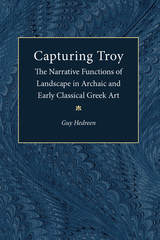
Capturing Troy
The Narrative Functions of Landscape in Archaic and Early Classical Greek Art
Guy Hedreen
University of Michigan Press, 2002
Those in the field of classical art will appreciate this investigation of the most common remnant of ancient Greek society available to the modern scholar, the painted vase. Guy Hedreen discusses how the imagery on Greek vases is only sometimes used as a narrative device, and delves further into the extent to which visual imagery depends upon literary sources. With the backdrop of one of the world's earliest, and some would argue greatest stories ever told, the sacking of Troy, Hedreen brings the reader into one of the most current and persistent topics in the art world: Narrative vs. Art. Employing a wide range of stunning visual imagery to illustrate his points, this insightful original text, Capturing Troy is a valuable new contribution to the subject, accessible to the learned scholar and beginning student alike.
Guy Michael Hedreen is Professor of Art, Williams College.
Guy Michael Hedreen is Professor of Art, Williams College.
[more]
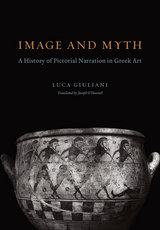
Image and Myth
A History of Pictorial Narration in Greek Art
Luca Giuliani
University of Chicago Press, 2013
On museum visits, we pass by beautiful, well-preserved vases from ancient Greece—but how often do we understand what the images on them depict? In Image and Myth, Luca Giuliani tells the stories behind the pictures, exploring how artists of antiquity had to determine which motifs or historical and mythic events to use to tell an underlying story while also keeping in mind the tastes and expectations of paying clients.
Covering the range of Greek style and its growth between the early Archaic and Hellenistic periods, Giuliani describes the intellectual, social, and artistic contexts in which the images were created. He reveals that developments in Greek vase painting were driven as much by the times as they were by tradition—the better-known the story, the less leeway the artists had in interpreting it. As literary culture transformed from an oral tradition, in which stories were always in flux, to the stability of written texts, the images produced by artists eventually became nothing more than illustrations of canonical works. At once a work of cultural and art history, Image and Myth builds a new way of understanding the visual culture of ancient Greece.
[more]

Maya Narrative Arts
Karen Bassie-Sweet
University Press of Colorado, 2018
In Maya Narrative Arts, authors Karen Bassie-Sweet and Nicholas A. Hopkins present a comprehensive and innovative analysis of the principles of Classic Maya narrative arts and apply those principles to some of the major monuments of the site of Palenque. They demonstrate a recent methodological shift in the examination of art and inscriptions away from minute technical issues and toward the poetics and narratives of texts and the relationship between texts and images.
Bassie-Sweet and Hopkins show that both visual and verbal media present carefully planned narratives, and that the two are intimately related in the composition of Classic Maya monuments. Text and image interaction is discussed through examples of stelae, wall panels, lintels, benches, and miscellaneous artifacts including ceramic vessels and codices. Bassie-Sweet and Hopkins consider the principles of contrast and complementarity that underlie narrative structures and place this study in the context of earlier work, proposing a new paradigm for Maya epigraphy. They also address the narrative organization of texts and images as manifested in selected hieroglyphic inscriptions and the accompanying illustrations, stressing the interplay between the two.
Arguing for a more holistic approach to Classic Maya art and literature, Maya Narrative Arts reveals how close observation and reading can be equally if not more productive than theoretical discussions, which too often stray from the very data that they attempt to elucidate. The book will be significant for Mesoamerican art historians, epigraphers, linguists, and archaeologists.
Bassie-Sweet and Hopkins show that both visual and verbal media present carefully planned narratives, and that the two are intimately related in the composition of Classic Maya monuments. Text and image interaction is discussed through examples of stelae, wall panels, lintels, benches, and miscellaneous artifacts including ceramic vessels and codices. Bassie-Sweet and Hopkins consider the principles of contrast and complementarity that underlie narrative structures and place this study in the context of earlier work, proposing a new paradigm for Maya epigraphy. They also address the narrative organization of texts and images as manifested in selected hieroglyphic inscriptions and the accompanying illustrations, stressing the interplay between the two.
Arguing for a more holistic approach to Classic Maya art and literature, Maya Narrative Arts reveals how close observation and reading can be equally if not more productive than theoretical discussions, which too often stray from the very data that they attempt to elucidate. The book will be significant for Mesoamerican art historians, epigraphers, linguists, and archaeologists.
[more]
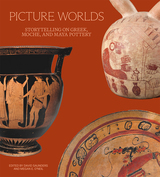
Picture Worlds
Storytelling on Greek, Moche, and Maya Pottery
David Saunders
J. Paul Getty Trust, The, 2024
This abundantly illustrated volume is the first to explore the painted pottery of the ancient Greek, Moche, and Maya cultures side by side.
Satyrs and sphinxes, violent legumes, and a dancing maize deity figure in the stories painted on the pottery produced by the ancient Greek, Moche, and Maya cultures, respectively. Picture Worlds is the first book to examine the elaborately decorated terracotta vessels of these three distinct civilizations. Although the cultures were separated by space and time, they all employed pottery as a way to tell stories, explain the world, and illustrate core myths and beliefs. Each of these painted pots is a picture world. But why did these communities reach for pottery as a primary method of visual communication? How were the vessels produced and used? In this book, experts offer introductions to the civilizations, exploring these foundational questions and examining the painted imagery. Readers will be rewarded with a better understanding of each of these ancient societies, fascinating insights into their cultural commonalities and differences, and fresh perspectives on image making and storytelling, practices that remain vibrant to this day.
This volume is published to accompany an exhibition on view at the J. Paul Getty Museum at the Getty Villa from April 10 to July 29, 2024, and at the Michael C. Carlos Museum at Emory University from September 14 to December 15, 2024.
Satyrs and sphinxes, violent legumes, and a dancing maize deity figure in the stories painted on the pottery produced by the ancient Greek, Moche, and Maya cultures, respectively. Picture Worlds is the first book to examine the elaborately decorated terracotta vessels of these three distinct civilizations. Although the cultures were separated by space and time, they all employed pottery as a way to tell stories, explain the world, and illustrate core myths and beliefs. Each of these painted pots is a picture world. But why did these communities reach for pottery as a primary method of visual communication? How were the vessels produced and used? In this book, experts offer introductions to the civilizations, exploring these foundational questions and examining the painted imagery. Readers will be rewarded with a better understanding of each of these ancient societies, fascinating insights into their cultural commonalities and differences, and fresh perspectives on image making and storytelling, practices that remain vibrant to this day.
This volume is published to accompany an exhibition on view at the J. Paul Getty Museum at the Getty Villa from April 10 to July 29, 2024, and at the Michael C. Carlos Museum at Emory University from September 14 to December 15, 2024.
[more]

Serial Selves
Identity and Representation in Autobiographical Comics
Frederik Byrn Køhlert
Rutgers University Press, 2019
Autobiography is one of the most dynamic and quickly-growing genres in contemporary comics and graphic narratives. In Serial Selves, Frederik Byrn Køhlert examines the genre’s potential for representing lives and perspectives that have been socially marginalized or excluded. With a focus on the comics form’s ability to produce alternative and challenging autobiographical narratives, thematic chapters investigate the work of artists writing from perspectives of marginality including gender, sexuality, disability, and race, as well as trauma. Interdisciplinary in scope and attuned to theories and methods from both literary and visual studies, the book provides detailed formal analysis to show that the highly personal and hand-drawn aesthetics of comics can help artists push against established narrative and visual conventions, and in the process invent new ways of seeing and being seen.
As the first comparative study of how comics artists from a wide range of backgrounds use the form to write and draw themselves into cultural visibility, Serial Selves will be of interest to anyone interested in the current boom in autobiographical comics, as well as issues of representation in comics and visual culture more broadly.
As the first comparative study of how comics artists from a wide range of backgrounds use the form to write and draw themselves into cultural visibility, Serial Selves will be of interest to anyone interested in the current boom in autobiographical comics, as well as issues of representation in comics and visual culture more broadly.
[more]
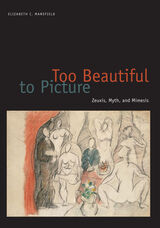
Too Beautiful to Picture
Zeuxis, Myth, and Mimesis
Elizabeth C. Mansfield
University of Minnesota Press, 2007
Few tales of artistic triumph can rival the story of Zeuxis. As first reported by Cicero and Pliny, the painter Zeuxis set out to portray Helen of Troy, but when he realized that a single model could not match Helen’s beauty, he combined the best features of five different models. A primer on mimesis in art making, the Zeuxis myth also illustrates ambivalence about the ability to rely on nature as a model for ideal form.In Too Beautiful to Picture, Elizabeth C. Mansfield engages the visual arts, literature, and performance to examine the desire to make the ideal visible. She finds in the Zeuxis myth evidence of a cultural primal scene that manifests itself in gendered terms. Mansfield considers the many depictions of the legend during the Renaissance and questions its absence during the eighteenth century. Offering interpretations of Angelica Kauffman’s paintings, Mary Shelley’s Frankenstein, and Picasso’s Les Demoiselles d’Avignon, Mansfield also considers Orlan’s carnal art as a profound retelling of the myth. Throughout, Mansfield asserts that the Zeuxis legend encodes an unconscious record of the West’s reliance on mimetic representation as a vehicle for metaphysical solace.Elizabeth C. Mansfield is associate professor of art history at the University of the South.
[more]
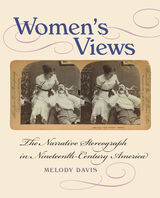
Women's Views
The Narrative Stereograph in Nineteenth-Century America
Melody Davis
University of Massachusetts Press, 2015
Few American homes were without a stereoscope in the 1890s. The immersive, three-dimensional experience of stereographs was among the most popular parlor entertainments of the late nineteenth and early twentieth centuries, a period of more than forty years.
In this remarkable book, Melody Davis analyzes the underexamined genre of narrative stereoviews and their audiences. Because stereoviews were created for and marketed primarily to middle-class women in domestic settings, Davis argues that they represent one of the best sources for addressing the flow of historical change in women's lives. By analyzing dozens of stereoviews—including depictions of gender stereotypes, power dynamics, comical or sentimental situations, and scenes of both serious and playful innuendo—Davis energetically spins a broad history of the real social, sexual, and economic changes in the lives of American women. Her close reading and rich contextualization of these compelling vernacular objects bridge the gaps between the private viewing that took place within the home and the outside world of consumption and power that women were gradually entering.
Illustrated with more than one hundred stereographs and including a three-dimensional viewer, this book will appeal to readers with an interest in U.S. women's history, the history of photography, visual and cultural studies, and American studies.
In this remarkable book, Melody Davis analyzes the underexamined genre of narrative stereoviews and their audiences. Because stereoviews were created for and marketed primarily to middle-class women in domestic settings, Davis argues that they represent one of the best sources for addressing the flow of historical change in women's lives. By analyzing dozens of stereoviews—including depictions of gender stereotypes, power dynamics, comical or sentimental situations, and scenes of both serious and playful innuendo—Davis energetically spins a broad history of the real social, sexual, and economic changes in the lives of American women. Her close reading and rich contextualization of these compelling vernacular objects bridge the gaps between the private viewing that took place within the home and the outside world of consumption and power that women were gradually entering.
Illustrated with more than one hundred stereographs and including a three-dimensional viewer, this book will appeal to readers with an interest in U.S. women's history, the history of photography, visual and cultural studies, and American studies.
[more]
READERS
Browse our collection.
PUBLISHERS
See BiblioVault's publisher services.
STUDENT SERVICES
Files for college accessibility offices.
UChicago Accessibility Resources
home | accessibility | search | about | contact us
BiblioVault ® 2001 - 2024
The University of Chicago Press









